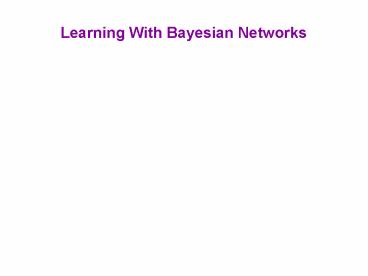Learning With Bayesian Networks - PowerPoint PPT Presentation
1 / 28
Title:
Learning With Bayesian Networks
Description:
Parameter Learning. Many models have uncertain variables that must be estimated from data. ... Given network structure Sh and parameter vector ?s ... – PowerPoint PPT presentation
Number of Views:46
Avg rating:3.0/5.0
Title: Learning With Bayesian Networks
1
Learning With Bayesian Networks
2
Parameter Learning
- Many models have uncertain variables that must be
estimated from data. - e.g., Mozer ordinal category model category
prototypes - e.g., thumbtack bias in thumbtack flipping
example
3
ALL SLIDES STOLEN FROM DAVID HECKERMAN TUTORIAL
4
(No Transcript)
5
(No Transcript)
6
(No Transcript)
7
(No Transcript)
8
(No Transcript)
9
(No Transcript)
10
(No Transcript)
11
(No Transcript)
12
(No Transcript)
13
background knowledge
14
(No Transcript)
15
(No Transcript)
16
(No Transcript)
17
(No Transcript)
18
(No Transcript)
19
NO
20
Learning Probabilities in a Bayes Net
- Fix network structure
- Use data to update the probabilities
- As in thumbtack example, probabilities are
variables - Given network structure Sh and parameter vector
?s - Given random sample D x1, x2, ..., xN,
compute the posterior distribution p(?s D, Sh) - Probabilistic formulation of all supervised and
unsupervised learning problems.
21
Local Distribution Functions
- Local distribution function is a probabilistic
classification or regression function. - e.g., linear regression, neural net, SVM, random
forest - Consider unrestricted multinomial distribution
- each variable Xi is discrete, with values xi1,
... xirI - i index over nodes of graphj index over
configurations of the parents of node ik index
over values of node i - unrestricted means one parameter per probability,
vs. low-dimensional functions of paij
LOCAL DISTRIBUTION FUNCTION
22
Computing Posterior DistributionOver Parameters
- Assume (1) no missing data, and (2) parameter
vectors are mutually independent. - E.g., net structure X?Y
23
Simplifying Learning
- Given complete data and
- Explanation
- Given complete data, each setof parameters is
disconnected fromeach other set of parameters in
the graph
?x
X
?x
?x
Y
?x
24
Prediction
- Given prior distribution
- Posterior distribution is
- Prediction with
- How can this be used for supervised learning?
25
Missing Data
- Y observed variablesZ unobserved variables
- How do we do parameter updates in this case?
- Dirichlet mixture
- unless Xi and Pai are observed in Y, each case
increases number of mixture components
dirichlet
26
Gibbs Samplingto Handle Missing Data
- 1. Given a set of observed incomplete data,D
y1, ..., yN - 2. Fill in arbitrary values for unobserved
variables for each case - 3. For each unobserved variable xi in case l,
sample - 4. evaluate posterior density on complete data
Dc' - 5. repeat steps 3 and 4, and compute mean of
posterior density
27
Gaussian Approximationto Handle Missing Data
- Approximateas a multivariate Gaussian.
- Appropriate if sample size is large, which is
also the case when Monte Carlo is inefficient - 1. define
- 2. find the configuration that maximizes g(.),
- 3. approximate using 2nd degree Taylor
polynomial - 4. leads to approximate result that is Gaussian
negative Hessian of g(.) eval at
28
Further Approximations
- As the data sample size increases,
- Gaussian peak becomes sharper, so can make
predictions based on the MAP configuration - can ignore priors (diminishing importance)
- How to do MAP estimation
- gradient ascent
- EM
- E step compute expected values of missing data
- M step maximize parameters given complete data Dc































